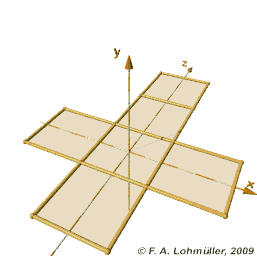 |
| A statue of two dragons in Varna. |
In our world, it seems that dragons shouldn't be able to exist. Reptiles don't fly, don't breathe fire, and don't grow to the size of buildings.
Some of these could possibly have evolved. Dragons might have descended from the same common ancestor as bird and reptiles, and diverged at the same time; it wouldn't be impossible for them to have some features similar to modern birds and others similar to modern reptiles.
Organisms have also developed many kinds of chemicals and poisons for defense...why not something similar to triethylaluminum, which ignites upon contact with oxygen? It can be synthesized from hydrogen, aluminum, and methane, none of which is too hard to find. And maybe dragons have a way to extract more oxygen from the air in their respiratory system, so they breathe out almost pure carbon dioxide (which would prevent them setting themselves on fire).
But there's one big problem: the square-cube law.
Edit: I've made a new post about the square-cube law, look here.
The square-cube law states that, as you scale something up, the volume changes faster than the surface area. The surface area increases as the square of the length, and the volume as the cube.
If you look at a graph of the two, you can see that they keep getting further and further apart.
And this applies to biology, because strength is proportional to the cross-section of the muscle, which is an area, while mass is proportional to the volume of the animal. This is why ants can lift such heavy weights compared to their own, but we can't. If you scaled an ant up to the size of a person, its legs would snap under the weight of its own body.
This is even more of a problem for things that fly. If you scaled up an airplane to double its size, it would weigh 23=8 times as much, but it would only get 22=4 times the lift of the smaller plane. It wouldn't even be able to take off.
So let's imagine we have a very small, fire-breathing dragon, a bit smaller than a Komodo monitor. Its bones could be hollow, like a bird's, to make it lighter. It could presumably be able to fly--after all, we've seen birds approximately that size that can fly perfectly fine.
Our small dragon is about two meters long. We want the full-sized dragon to be, say, 64 meters long, 32 times longer. Its new surface area will be 1024 times its original, but its new volume will be 32,768 times larger!
So there's no way it could fly, although with enough muscle it might be able to support itself. Possibly.
Or are we missing something?
Now I'm going to deviate completely from reality, so you might want to read the previous two posts first.
Imagine that we have a fold in the world, but not a complete one like in the previous posts. Only a partial one. This dragon could essentially create a little "ledge" for itself, in which gravity would be reduced or even negated.
Now it would have no problems! There are animals larger than it on Earth which survive just fine--blue whales, because they live in the water. The buoyant force essentially weakens gravity, so they can move however they want in three dimensions.
Let's assume, however, that our dragon is purely three-dimensional. I don't even want to try analyzing the "cube-tesseract law."
TL;DR: It's perfectly possible that dragons exist, even though the square-cube law still holds. They could even fly and breathe fire.








